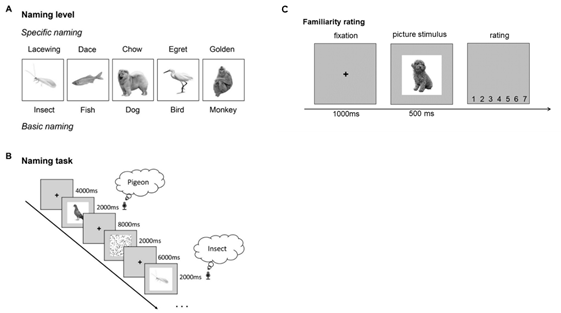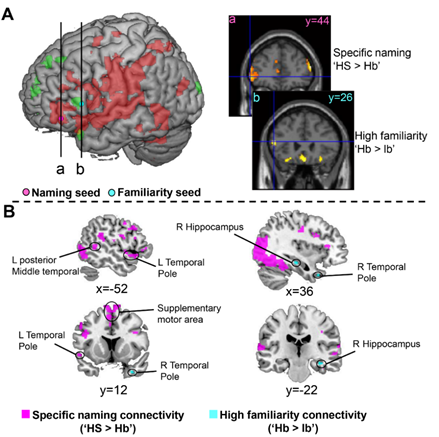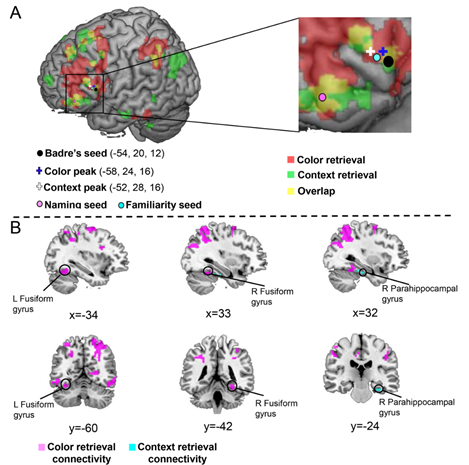On February 17, 2020, a paper entitled “Convergence of distinct functional networks supporting naming and semantic recognition in the left inferior frontal gyrus” was online published in Human Brain Mapping by Dr. Yuji Naya’s group at the School of Psychological and Cognitive Sciences at Peking University, and the PKU-IDG/McGovern Institute for Brain Research.
Naming individual objects is accompanied with semantic recognition. Previous studies examined brain-networks responsible for these operations individually (Gorno-Tempini & Price, 2001; Abel et al., 2015). However, it remains unclear how these brain-networks are related. To address this problem, we examined the brain-networks during a novel object-naming task, requiring participants to name animals at a specific-level (e.g., “pigeon”, Fig. 1A&B). When the participants could not remember specific names, they answered basic names (e.g., “bird”). After fMRI scanning during the object-naming task, the participants rated familiarity of the animals based on their sense of knowing. Since participants tend to remember specific names for familiar objects compared with unfamiliar objects, a typical issue in an object-naming task is an internal covariance between the naming and familiarity levels (Fig. 1C).

Fig 1, Naming task and post-scan familiarity-rating task.
We removed this confounding factor by adjusting the familiarity/naming level of stimuli, and demonstrated distinct brain regions related to the two operations. Among them, the left inferior frontal gyrus triangularis (IFGtri) contained object-naming and semantic-recognition related areas in its anterior-ventral and posterior-dorsal parts, respectively. This region has been considered as a core region of semantic control (Lambon Ralph et al., 2017). Further PPI analysis found that the left IFGtri connected with word-production brain areas (e.g., left TP, STG) under naming condition, and with the right temporal pole and hippocampus under recognition condition (Fig. 2).

Fig 2, Brain regions connected with left IFG in contrast: HS > Hb, and contrast: Hb > lb.
By examining the connectivity under control tasks requiring nonlexical semantic retrieval (e.g., animal's body color), we found that both left IFGtri parts (anterior-ventral and posterior-dorsal parts) altered their targeting brain areas (with fusiform and lingual gyrus under color retrieval; with parahippocampal gyrus under context retrieval) according to the required memory attributes, while only the posterior-dorsal part connected the brain regions related to semantic recognition (Figs. 2&3). Together, the semantic recognition may be processed by distinct brain network from those for voluntary semantic retrievals including object-naming although all these networks are mediated by the posterior-dorsal IFGtri.

Fig 3, PPI analyses of IFG triangularis seed areas during context retrieval and color retrieval.
A, seed positions of the feature retrieval task PPI analyses; B, results of the PPI analyses.
This study was supported by National Natural Scientific Foundation of China (NSFC). The corresponding author is Dr. Yuji Naya. The first author is Zhansheng Xu, a Ph.D. student from School of Psychological and Cognitive Sciences of Peking University.
Link of the paper: https://doi.org/10.1002/hbm.24953
Reference
Abel, T. J., Rhone, A. E., Nourski, K. V., Kawasaki, H., Oya, H., Griffiths, T. D., Howard III, M. A., & Tranel D. (2015). Direct physiologic evidence of a heteromodal convergence region for proper naming in human left anterior temporal lobe. Journal of Neuroscience, 35, 1513–1520.
Gorno-Tempini, M. L., & Price, C. J. (2001). Identification of famous faces and buildings A functional neuroimaging study of semantically unique items. Brain, 124, 2087–2097.
Lambon Ralph, M. A., Jefferies, E., Patterson, K., & Rogers, T. T. (2017). The neural and computational bases of semantic cognition. Nature Reviews Neuroscience, 18, 42–55.


